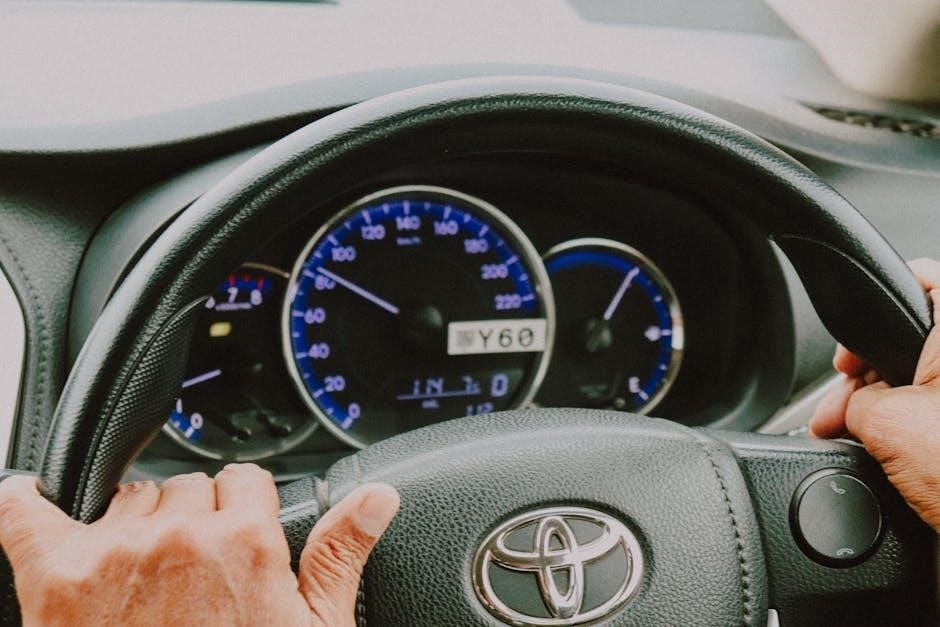
The Arizona Drivers License Manual is a comprehensive guide designed to help residents understand traffic laws, licensing procedures, and safe driving practices. It covers essential information for obtaining, renewing, or transferring a driver’s license, ensuring compliance with state regulations. The manual is a valuable resource for both new and experienced drivers, providing detailed insights into road safety, MVD services, and legal requirements.
1.1 Purpose and Importance of the Manual
The Arizona Drivers License Manual serves as a vital resource for understanding the rules of the road, licensing requirements, and safe driving practices. Its primary purpose is to educate drivers on state-specific traffic laws, ensuring compliance and promoting road safety. The manual is essential for both new and experienced drivers, providing detailed information on obtaining, renewing, or transferring a license. It also highlights critical safety tips and legal obligations, making it an indispensable guide for all Arizona motorists aiming to drive responsibly and avoid penalties.
1.2 Structure and Content Overview
The Arizona Drivers License Manual is organized into clear sections, making it easy to navigate. It begins with an introduction, followed by eligibility criteria, application processes, driving requirements, and traffic laws. The manual also covers license types, fees, and MVD services, ensuring all aspects of licensing are addressed. Each section provides detailed explanations, examples, and essential information, allowing readers to understand and comply with Arizona’s driving regulations effectively. This structured approach ensures drivers are well-prepared for tests and safe on the road.
1.3 How to Use the Manual Effectively
To use the Arizona Drivers License Manual effectively, start by reviewing the table of contents to identify key sections relevant to your needs. Focus on chapters related to license types, application processes, and driving laws. Utilize the practice tests provided to assess your knowledge and identify areas for improvement. Pay attention to highlighted safety tips and legal requirements to ensure compliance. By systematically studying each section, you can gain a thorough understanding of Arizona’s driving regulations and prepare confidently for your license application or renewal.

Eligibility Criteria for Obtaining an Arizona Driver License
Eligibility for an Arizona driver license requires meeting age, residency, and legal presence standards. Applicants must pass vision and knowledge tests and provide required documents.
2.1 Types of Driver Licenses in Arizona
Arizona offers several types of driver licenses, including Class D for passenger vehicles, Class M for motorcycles, and Commercial Driver Licenses (CDL) for heavy vehicles. A Class D license is the most common, allowing operation of non-commercial vehicles. Class M licenses require a motorcycle endorsement or a separate motorcycle-only license. CDLs are for drivers operating commercial vehicles and require additional testing and endorsements. Each license type has specific eligibility criteria and requirements to ensure safe and legal driving privileges.
2.2 Age Requirements for Applying
In Arizona, the minimum age to apply for a driver license varies based on the type of license. Teens can obtain a Class D instruction permit at 15 years and 6 months old, allowing supervised driving. At 16, they can apply for a restricted license, which limits passengers and nighttime driving. Full unrestricted privileges are granted at 18 years old. Applicants under 18 must complete driver education and log supervised driving hours. Adults 18 and older can directly apply for a Class D license without restrictions.
2.3 Residency and Legal Presence Requirements
To apply for an Arizona driver license, applicants must establish residency and legal presence in the U.S. Proof of residency can be demonstrated with documents like utility bills, bank statements, or rental agreements. Legal presence requires valid immigration status, such as a birth certificate, passport, or green card. Non-citizens must provide documentation from the U.S. Citizenship and Immigration Services (USCIS). Arizona adheres to federal REAL ID standards, ensuring compliance with identity verification for licenses accepted at airports and federal facilities.

The Application Process for an Arizona Driver License
The Arizona driver license application process involves gathering required documents, completing the application form, visiting an MVD office, and passing necessary tests for approval.
3.1 Required Documents for Application
To apply for an Arizona driver license, you must provide specific documents proving identity, residency, and legal presence. These include a valid birth certificate, passport, or permanent resident card for identity. Proof of residency can be a utility bill, lease agreement, or bank statement. Additional documents, such as a Social Security card or W-2 form, may be required. Minors need parental consent, while name changes require a marriage certificate or court order. Ensure all documents are original or certified copies to avoid delays in processing your application.
3.2 Completing the Application Form
The application form for an Arizona driver license must be filled out accurately and completely. You can obtain the form online or at an MVD office. Ensure all personal details, such as name, address, and date of birth, are correct. Provide residency and legal presence information, and disclose any medical conditions that may affect driving. Incomplete or incorrect forms will delay processing. Double-check all information before submitting to avoid errors. Proper completion ensures a smooth application process and faster issuance of your license.
3.3 Attending an MVD Office
When visiting an Arizona MVD office, arrive prepared with all required documents to avoid delays. Check the MVD website for wait times and consider scheduling an appointment. Be ready to complete any necessary tests, such as vision or knowledge exams. Ensure you bring payment for applicable fees, as accepted methods vary by location. Some services may also be available online to expedite your visit. Proper preparation and understanding of the process will help make your experience efficient and stress-free.
Driving Requirements and Tests
Arizona requires applicants to pass vision, knowledge, and driving tests to ensure safe and lawful driving. These assessments evaluate understanding of traffic laws and practical driving skills.
4.1 Vision Test Requirements
The vision test is a critical component of the licensing process in Arizona, ensuring applicants can safely operate a vehicle. It assesses visual acuity and field of vision. Applicants must meet minimum standards, with or without corrective lenses. Those failing the test may need to undergo a medical evaluation or provide a report from an eye specialist. The test is straightforward, typically involving an eye chart reading to measure sharpness and peripheral vision. Proper vision is essential for reacting to road hazards and adhering to traffic laws.
4.2 Knowledge Test Overview
The Arizona knowledge test evaluates understanding of traffic laws, road signs, and safe driving practices. It is required for all license applicants, including first-time drivers. The test consists of multiple-choice questions and is available in various languages. To pass, applicants must answer at least 80% of the questions correctly. Study materials, such as practice tests and the Arizona Driver License Manual, are available online to help prepare. Passing the test demonstrates a foundational knowledge of driving rules and safety principles, ensuring readiness for the road.
4.3 Behind-the-Wheel Driving Test
The behind-the-wheel driving test evaluates a driver’s ability to operate a vehicle safely and competently. Applicants must demonstrate proficiency in basic vehicle control, traffic law adherence, and defensive driving techniques. The test includes parallel parking, three-point turns, and navigating various road conditions. Evaluators assess the driver’s ability to interact with traffic, use signals correctly, and maintain safe following distances. The test is conducted in a real-world setting to ensure practical driving skills are verified. Passing this test is a final step toward obtaining an Arizona driver license.

Traffic Laws and Safe Driving Practices
The Arizona Drivers License Manual educates drivers on state traffic laws, safe driving practices, and the importance of compliance to ensure safety on Arizona roads.
5.1 Key Arizona Traffic Laws
Arizona traffic laws emphasize safety and legal compliance. Key regulations include mandatory seatbelt use for all passengers, strict enforcement of speed limits, and penalties for reckless driving. Drivers must also adhere to right-of-way rules, particularly at intersections and when merging onto highways. Additionally, Arizona has a zero-tolerance policy for underage drinking and driving. The state enforces DUI laws rigorously, with severe penalties for driving under the influence of alcohol or drugs; These laws aim to reduce accidents and ensure a safe driving environment for all road users.
5.2 Safe Driving Practices
Safe driving practices are essential for reducing accidents and ensuring the well-being of all road users. Always maintain a safe distance from other vehicles, use turn signals consistently, and avoid distractions like texting while driving. Be cautious in school zones and when sharing the road with pedestrians, cyclists, and emergency vehicles. Adhere to speed limits and adjust your speed according to weather conditions. Never drive under the influence of alcohol or drugs, as Arizona enforces strict DUI laws. Defensive driving and awareness of surroundings are key to preventing collisions and promoting a safer driving environment.
5.3 Emergency Procedures
In case of an accident, remain calm and ensure everyone’s safety. Move to a safe location if possible and call 911 immediately. Exchange information with all parties involved, including names, contact details, and insurance information. Document the scene with photos if safe to do so. Notify the Arizona MVD within 10 days of the incident. For breakdowns, turn on hazard lights and stay in your vehicle until help arrives. Keep an emergency kit in your car, including a first-aid kit, flashlight, and reflective triangles. Always be prepared for unexpected situations on the road.

License Types and Classifications
Arizona offers Class D, M, and Commercial Driver Licenses (CDL). Class D is for non-commercial vehicles, Class M for motorcycles, and CDL for heavy commercial vehicles. The manual details each classification, helping drivers choose the appropriate license for their needs and ensuring compliance with state driving laws and regulations.
6.1 Class D Driver License
The Class D Driver License is Arizona’s standard non-commercial license, allowing operation of passenger vehicles, SUVs, and trucks with a GVWR of less than 26,001 pounds. Eligibility requires Arizona residency, legal presence, and passing vision, knowledge, and driving tests. Applicants must be at least 16 years old, with those under 18 needing parental consent. This license is valid for two to six years, depending on age and legal status; It does not permit operation of motorcycles or commercial vehicles, which require separate classifications.
6.2 Class M Driver License
The Class M Driver License is issued for operating motorcycles in Arizona. Eligibility requires applicants to be at least 16 years old, with those under 18 needing parental consent. Applicants must pass a vision test, motorcycle knowledge test, and a motorcycle skills test. A fee is required for the license and testing. Completion of a motorcycle safety course may be optional but is recommended. This license does not permit operation of non-motorcycle vehicles, distinguishing it from the Class D license.
6.3 Commercial Driver Licenses (CDL)
A Commercial Driver License (CDL) is required to operate large commercial vehicles in Arizona. Eligibility includes being at least 21 years old, though some states allow 18 for intrastate driving. Applicants must meet residency and legal presence requirements. The process involves passing a DOT physical exam, vision test, knowledge test on commercial driving regulations, and a skills test. CDLs are classified into Class A, B, and C, depending on the type of vehicle and its weight. Endorsements are needed for specialized vehicles like tankers or hazardous materials. This license ensures drivers meet federal safety standards and demonstrates the ability to handle complex machinery safely.

Fees and Payment Methods
The Arizona MVD outlines specific fees for driver license applications, renewals, and replacements. Accepted payment methods include credit/debit cards, cash, and checks. Refunds are processed as per state policies.
7.1 License Application Fees
The Arizona MVD charges specific fees for driver license applications. A Class D license costs $12, while a Class M motorcycle license is $25. Additional fees apply for duplicates, replacements, or testing. Payments are accepted via credit/debit cards, cash, or checks. These fees cover administrative and processing costs. For accurate and updated pricing, visit the official Arizona MVD website or contact your local office. Ensure to verify the required payment methods and potential additional charges before submitting your application.
7.2 Accepted Payment Methods
The Arizona MVD accepts various payment methods for license applications, including cash, credit cards (Visa, MasterCard, and Discover), debit cards, and personal checks. Money orders are also accepted. However, some MVD offices may have specific payment restrictions, so it’s advisable to call ahead to confirm. Online transactions typically require a credit or debit card. Ensure your payment covers the total fees, as refunds are not issued for overpayments. This flexibility ensures a convenient and efficient process for applicants.
7.3 Refund and Reimbursement Policies
The Arizona MVD offers limited refunds for certain transactions. Refunds are typically issued if an application is denied or if duplicate payments are made. However, once a driver license or ID card has been processed and issued, fees are non-refundable. Applicants must contact the MVD directly to inquire about eligibility for refunds or reimbursements. Refunds are usually processed within 30 days and returned via the original payment method. It’s important to review all application details carefully to avoid unnecessary fees or complications.

Obtaining a Driver License After Moving to Arizona
This section guides new Arizona residents through the process of obtaining a driver license, including transferring out-of-state licenses, required documents, and updating records.
8.1 Transferring an Out-of-State Driver License
Transferring an out-of-state driver license to Arizona involves specific steps. Residents must visit an MVD office, surrender their current license, and provide proof of residency and legal presence. A vision test is required, and applicants must pay the applicable fees. The process ensures compliance with Arizona driving laws. Once completed, applicants receive a temporary permit, and their new license is mailed within 10-15 business days. This process streamlines the transition for new residents, ensuring they meet all state requirements efficiently.
8.2 Steps to Obtain an Arizona Driver License
To obtain an Arizona driver license, applicants must follow a structured process. First, gather all required documents, including proof of identity, residency, and legal presence. Next, complete the application form, which can be done online or in person at an MVD office. Pass a vision test and a knowledge test to demonstrate understanding of traffic laws. Afterward, schedule and pass a behind-the-wheel driving test. Upon successful completion, pay the applicable fees and receive your license. Additional requirements may apply for minors, such as parental consent.
8.3 Updating Address Information
Updating your address on an Arizona driver license is essential for maintaining accurate records. Residents can update their address online through the Arizona MVD portal or by visiting an MVD office. To complete the process, you must provide proof of residency, such as a utility bill or lease agreement. Online updates are typically processed within 24 hours, while in-person updates are handled immediately. Ensure your address is current to receive important notifications and avoid potential legal issues. This step ensures compliance with state regulations and keeps your license information up to date.

Understanding the Arizona Driver License Document
The Arizona driver license document features advanced security elements to prevent fraud. It includes a unique document number, expiration date, and personal details. The format ensures authenticity and ease of verification, while the document number helps track and manage license records efficiently.
9.1 Format and Security Features
The Arizona driver license features a modern design with enhanced security elements to combat fraud. The document includes a unique nine-character number, starting with a letter followed by eight digits, ensuring easy identification. Advanced security features such as holograms, UV printing, and microprinting are incorporated to prevent tampering. The card material is durable, and the layout is organized for quick verification. These features ensure authenticity and protect against identity theft, making the Arizona driver license a secure form of identification.
9.2 Document Number Explanation
The Arizona driver license document number is a unique nine-character identifier, typically starting with a letter followed by eight digits. This format ensures each license is distinct, preventing duplication and enhancing security. The document number is circled for easy identification and appears on both the front and back of the license. It is used for verification purposes and helps maintain accurate records within the Arizona Department of Transportation Motor Vehicle Division (ADOT MVD). This unique numbering system aids in identity verification and supports legal compliance.
9.3 Validity and Expiration Dates
An Arizona driver license is valid for a specific period, typically ranging from four to eight years, depending on the applicant’s age and license type. The expiration date is printed on the front of the license and signifies the end of its validity. Drivers must renew their license before or by the expiration date to maintain legal driving privileges. A grace period may apply, but failure to renew in time can result in penalties. Renewal options include online, mail, or in-person applications, ensuring convenience for Arizona motorists.

MVD Services and Resources
The Arizona MVD offers various services, including driver license applications, vehicle registration, and ID card issuance. Online tools provide convenience for renewals, appointments, and practice tests.
10.1 Locating an MVD Office
To locate an MVD office in Arizona, visit the official Arizona Department of Transportation (ADOT) MVD website. Use the office locator tool, which allows you to search by city, ZIP code, or county. You can filter results based on the services offered, such as driver license applications or vehicle registration. Additionally, contact the MVD hotline or check their website for office hours, addresses, and specific service details. Ensure to verify the closest office near you before visiting, as services may vary by location. This resource helps streamline your MVD experience and save time.
10.2 Online Services and Tools
The Arizona Department of Transportation (ADOT) MVD offers a variety of online services to simplify driver license and vehicle-related tasks. Residents can schedule appointments, renew driver licenses, and access practice tests through the official ADOT MVD website. Online tools also include document verification, application status tracking, and fee calculators. Additionally, the MVD provides an online portal for submitting paperwork and payments, reducing the need for in-person visits. These digital resources aim to enhance convenience and efficiency for Arizona motorists, ensuring a smoother experience when managing driver license needs.
10.3 Practice Tests and Study Materials
The Arizona MVD provides official practice tests and study materials to help applicants prepare for driver license exams. These resources include online practice tests covering traffic laws, road signs, and safe driving practices. Additionally, the Arizona Driver License Manual is available for download, offering detailed information on state-specific rules and regulations. Interactive quizzes and study guides are also accessible to ensure applicants are well-prepared for both the knowledge and driving tests, increasing their chances of success on the first attempt. These tools are designed to be user-friendly and accessible online.

Important Dates and Deadlines
Track license renewal deadlines, application submission timelines, and compliance dates to avoid penalties. Stay informed about expiration dates and required actions to maintain driving privileges in Arizona.
11.1 License Application Deadlines
Understanding application deadlines is crucial for obtaining or renewing an Arizona driver license. The Arizona MVD typically requires applicants to submit their applications within specific timeframes, especially for renewals. Licenses usually expire every four to six years, with renewal options available up to 60 days before expiration. Missing deadlines may result in late fees or penalties. Applicants are encouraged to check their license expiration date and apply well in advance to avoid disruptions in driving privileges. Utilize MVD online services to track deadlines and ensure timely submission.
11.2 Renewal and Expiration Dates
Arizona driver licenses have specific renewal and expiration dates to ensure compliance with state regulations. Licenses typically expire every four to six years, depending on the type and applicant’s age. Renewal applications must be submitted before the expiration date to maintain driving privileges. A grace period may apply, but late renewals could incur additional fees. Residents are encouraged to monitor their license expiration dates and renew promptly, either online, by mail, or in person, to avoid interruptions in their ability to legally operate a vehicle.
11.3 Compliance and Penalty Information
Compliance with Arizona driver license regulations is crucial to avoid penalties; Failing to renew a license on time may result in fines or reinstatement fees. Driving with an expired or suspended license can lead to penalties, including increased insurance rates or even license revocation. Additionally, accumulating excessive traffic violations may result in points on your record, potentially leading to mandatory driver improvement courses or license suspension. Understanding and adhering to these requirements ensures lawful driving privileges and prevents unnecessary legal consequences.